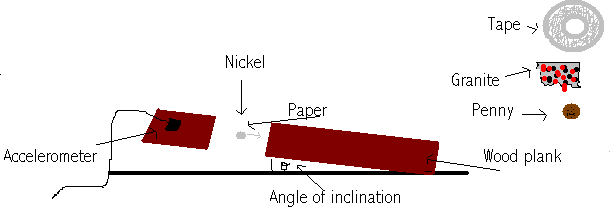Coefficients of Friction for Paper
An educational, fair use website
Friction, a vector quantity, is the force that opposes the relative motion of two objects in contact. Friction is always parallel to the two surfaces in contact and acts in the direction that opposes slipping. Static friction is the force that opposes the start of motion. Kinetic friction is the friction between objects in contact when they are in motion. The force of friction is directly proportional to the magnitude of the normal fore and depends on the coefficnet of friction (μ).
f = μN
The following is the procedure:
- Tape an accelerometer on the surface of a wood plank so it does not slide off.
- Tape a piece of paper on the surface the wood plank.
- In each of the four trials, place the object to be tested (granite block, penny, nickel, roll of transparent tape) on the paper and raise the wood plank off the table until the material slides off of the paper.
- Record the component of the acceleration due to gravity parallel to the plank at the moment the object slips.

On an inclined surface, the force of friction is directly proportional to the normal force, which is equal in magnitude but opposite in direction to the perpendicular component of the object's weight. As the angle of inclination increases, the normal force decreases.
Fnet = ma = 0
W//–f = 0
mg sin θ–μmg cos θ = 0
g sin θ = μg cos θ
The coefficient of friction is the ratio of frictional force to the normal force.
μ = sin θ/cos θ = tan θ
| Material | g// (m/s2) | θ (°) | μs |
|---|---|---|---|
| Granite | 3.69 | 22.12 | 0.41 |
| Penny | 2.72 | 16.11 | 0.29 |
| Nickel | 2.63 | 15.58 | 0.28 |
| Tape | 4.28 | 25.89 | 0.49 |
Kristina Arthurs, Monique Anthony, Nadia Christopher -- 2005
Students Choice:
- Electricity & Magnetism
- Acceleration
- Index of refraction of various household liquids
- Coefficients of Friction